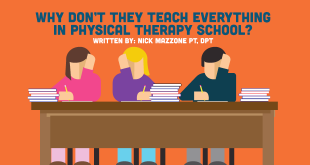When I was in college at Texas A&M, my main goal was to get in, get out, and get into physical therapy school. All I wanted was a bachelor’s degree because I knew it was a prerequisite for applying to physical therapy school. I had no intention of using my undergraduate degree to get a job and I certainly did not view my time in college as a chance to prepare for PT school. I saw college as a stepping stone to graduate school.
In my opinion, college was an entirely separate, but necessary, entity to reaching my end goal. I now realize that I would have been better off had I treated undergrad as a building block to PT school.
Looking back, there are several actions I could have taken as an undergrad to better prepare for PT school. We have many opportunities to set ourselves up for successful careers as physical therapists before we even graduate college.
How can you prepare for PT school as an undergrad?
1. Take your anatomy class seriously
I can’t even begin to explain how much I regret not taking my undergrad anatomy and physiology course seriously. Anatomy is an essential part of being successful in PT school. Quite frankly, it is also essential to working as a physical therapist in the real world. You will use anatomy every day for the rest of your career as a physical therapist. As movement experts, it is critical that we know what we are talking about when it comes to the body.
I experienced firsthand how important it is to truly learn anatomy in college. As an undergrad, I crammed for every anatomy exam and I therefore retained nothing. When I got to PT school, I had to re-learn everything!
In PT school, I had to study in a manner that allowed me to actually retain the information. I had to work my GLUTES off to get through clinical anatomy. I remember staying up every night going over actions, origins, and insertions, wishing I had learned it all the first time around. I missed out on a valuable opportunity to prepare for PT school before I even got there.
If you’ve already taken anatomy, and like me, crammed and retained nothing, don’t worry it’s going TIBIA okay. Everyone comes from different schools and different anatomy classes, so we all start off on a different FOOT. Excuse the cheesy puns – the point is, I got through it. It is doable, but it is not ideal.
Physical therapy has some level of direct access in all 50 states. With this change, it is critical that we develop a comprehensive understanding of all body systems. PTs must be able to differentiate between a systemic issue and a musculoskeletal/neuromuscular issue.
We need to know when a case is beyond our scope of practice and when we should refer. Understanding the basics of anatomy and physiology is essential to this process.
2. Volunteer in different settings
Another one of my regrets from undergrad is not volunteering in more clinical settings prior to PT school. When I was in college, I only spent time in outpatient clinics and I therefore did not experience any types of acute care settings. I wish I had exposed myself to more PT environments so that I could have entered school with a more complete understanding of the physical therapy profession. Since I only experienced outpatient settings for my observation hours, I entered school with a narrow view of physical therapy.
Regardless of your experience, it is important to expose yourself to a variety of settings in order to best prepare for PT school. Exposure to different volunteer experiences will allow you to have a better idea of the various settings physical therapy has to offer.
3. Become a part of #socialPT conversations
Conversations between physical therapists and student physical therapists are everywhere! Unfortunately, I had limited involvement with these conversations as an undergrad.
When I was in college, I stumbled on a podcast that was run by student PTs. They interviewed practicing PTs and current students about their experiences with the profession. It was a great outlet for me, but I wish I had found more podcasts and social media resources like it while I was still in college. At the time, I failed to realize that there is an entire network of PTs and student PTs on the internet!
PTs are on Twitter, Facebook, Instagram, and podcasts. They are having open conversations and sharing their knowledge and experiences. I only wish I had been more connected by reaching out through other physical therapy social media outlets. Immersing yourself in these conversations as an undergrad will not only allow you to prepare for PT school, but will also leave you ready to network after you graduate.
Get involved early
Current PTs and student PTs are awesome and usually willing to answer any questions. If you are thinking about dedicating finances and 2-3 years of your life to PT school, then make sure this is the career for you. It is important to to learn as much as you can about physical therapy so that you can discover an area you are truly passionate about.
The options within the profession of physical therapy are endless. There are numerous special interest groups, a wide variety of clinical settings, and many different patient populations across the field.
Physical therapy is a fluid and evolving profession in which your education never stops. By getting involved early, you can become adapted to this lifetime of learning. You will also be better prepared to face any obstacles that may come your way in school and at work. Use your time in undergrad to get a head start on the path to becoming a physical therapist – your future self will thank you!
 NewGradPhysicalTherapy.com The Largest Online Resource For New Grad Physical Therapists
NewGradPhysicalTherapy.com The Largest Online Resource For New Grad Physical Therapists







